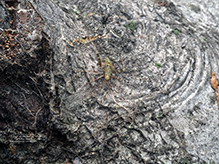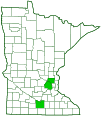plant bug
(Phytocoris tibialis)
Conservation • Description • Habitat • Ecology • Distribution • Taxonomy
|
|
||||||||||||||
Description |
Phytocoris tibialis is a small, native, easily recognized, plant bug. It occurs in the United States and southern Canada east of the Great Plains. It also occurs in Mexico. Adults are active from June through September. They are found in damp areas on weedy herbaceous plants. Adults are 3⁄16″ (5.0 to 5.5 mm) in length and 1⁄16″ (1.90 to 2.00 mm) wide. The body is elongated and almost parallel sided. It is light green or yellowish green (pale) with orange, reddish, and dark brownish gray markings. The surface is thinly covered with yellowish to brownish gray hairs mixed with yellowish silky hairs. The head is pale. The compound eyes are large. There are no simple eyes (ocelli). The front of the head has some irregular dark marks and an orange transverse line between the base of the eyes. The mouth parts are optimized for piercing and sucking. They take the form of a long, pale, 4-segmented beak. When not used, the beak extends from the front of the head, along the underside of the body between the legs, to the plate (ventral) on the sixth abdominal segment. The antennae are slender and thread-like. They have 4 segments. Segment 1 is yellowish white with 4 or 5 dark reddish-brown marks. Segments 2 and 3 are mostly pale, yellowish white just at the base. Segment 4 is pale. The exoskeletal plate covering the first segment of the thorax (pronotum) is widest at the base and much narrower behind the head. It has a short but distinct, exposed collar in front. There is a small, oval tubercle (callus) at the front outer angle on each side of the pronotum behind the collar. The surface of the pronotum is pale with 4 short, broad, longitudinal, orange stripes. In the front the stripes are interrupted at the calli but continue onto the collar. In the rear they do not reach the margin of the pronotum. There are two pairs of wings, and they are held flat over the body when at rest. The exoskeletal plate between the wing bases (scutellum) is large, triangular, and mostly dark. There is a dark dash on each side near the tip, and the tip itself is dark, but these marks are sometimes faint or indistinct. The front wings (hemelytra) are longer than the hind wings and a little longer than the body. The hemelytra have a thickened, leathery part at the base and a thin membranous part at the tip with a clear dividing line between the two. The thickened part is comprised of the narrow area (clavus) behind the scutellum when the wings are closed, and the broad marginal area (corium). At the end of the corium there is a small but distinct triangular area (cuneus). The clavus is dark grayish brown with a red spot at the base and sometimes a second one near the middle. The corium is pale. The inner margin adjacent to the clavus has an irregular row of red spots. The cuneus is pale. There is a small but distinct black spot at the inner basal angle, and the tip is red. The membrane is pale and usually slightly darkened, at least near the base. The veins are white and they are bordered inside with dark, but they are often faint or indistinct. The hind wings are thin and membranous. The legs are relatively long. They are pale with numerous dark markings. The third segment (femur) of each leg is pale at the base. The femurs on the hind leg is mostly dark with pale spots near the tip. |
Size |
Total length: 3⁄16″ (5.0 to 5.5 mm) |
Similar Species |
Habitat |
|
Ecology |
Season |
June through September |
Behavior |
|
Life Cycle |
Eggs overwinter. |
Nymph Hosts |
|
Adult Food |
|
Distribution |
||
|
Sources |
|
| 2/1/2025 | ||
Occurrence |
||
|
||
Taxonomy |
|
Order |
Hemiptera (True bugs, Hoppers, Aphids, and Allies) |
Suborder |
Heteroptera (True Bugs) |
Infraorder |
Cimicomorpha |
Superfamily |
Miroidea |
Family |
|
Subfamily |
Mirinae |
Tribe |
Mirini |
Genus |
Phytocoris |
Subordinate Taxa |
|
|
|
Synonyms |
|
Phytocoris vilis |
|
Common Names |
|
This species has no common name. The common name for the family Miridae is plant bugs, and it is applied here for convenience. |
|
Glossary
Clavus
On Hemiptera: The hard part of the forewing that is adjacent to the scutellum when the wings are closed. Plural: clavi.
Corium
The thickened basal portion of the front wing that lies between the clavus and the membrane of insects in the family Hemiptera. Plural: coria.
Cuneus
The triangular, hardened, horn-like tip of the forewing of a plant bug (family Miridae).
Femur
On insects and arachnids, the third, largest, most robust segment of the leg, coming immediately before the tibia. On humans, the thigh bone.
Hemelytron
The forewing of true bugs (order Hemiptera), thickened at the base and membranous at the tip. Plural: hemelytra.
Ocellus
Simple eye; an eye with a single lens. Plural: ocelli.
Pronotum
The exoskeletal plate on the upper side of the first segment of the thorax of an insect.
Scutellum
The exoskeletal plate covering the rearward (posterior) part of the middle segment of the thorax in some insects. In Coleoptera, Hemiptera, and Homoptera, the dorsal, often triangular plate behind the pronotum and between the bases of the front wings. In Diptera, the exoskeletal plate between the abdomen and the thorax.
Vertex
The upper surface of an insect’s head.
Visitor Photos |
||
Share your photo of this insect. |
||
This button not working for you? |
||
Alfredo Colon |
||
 |
 |
|
MinnesotaSeasons.com Photos |
||
|
||
|
||

Slideshows |
|

Visitor Videos |
||
Share your video of this insect. |
||
This button not working for you? |
||
|
Other Videos |
||
|

|
Created: 2/1/2025 Last Updated: © MinnesotaSeasons.com. All rights reserved. |


